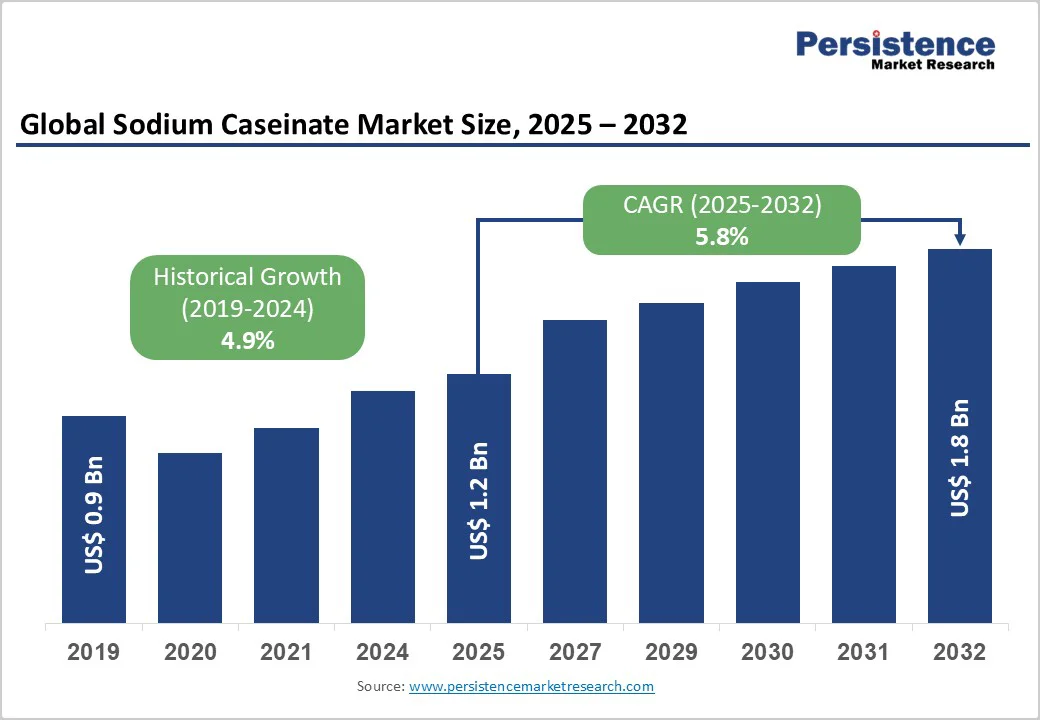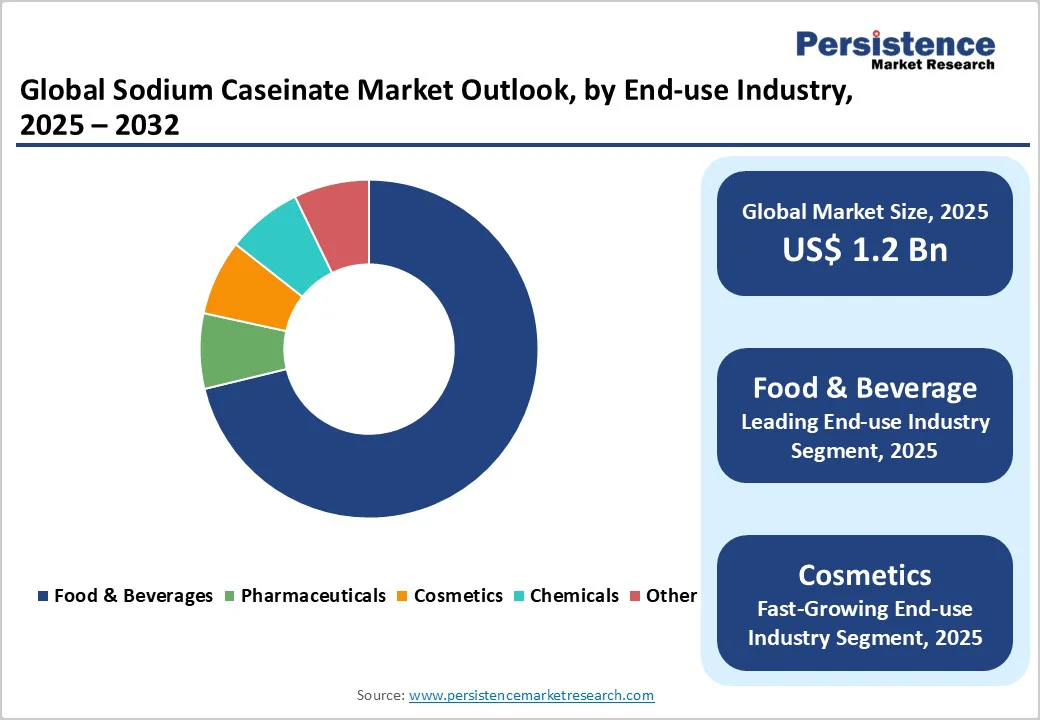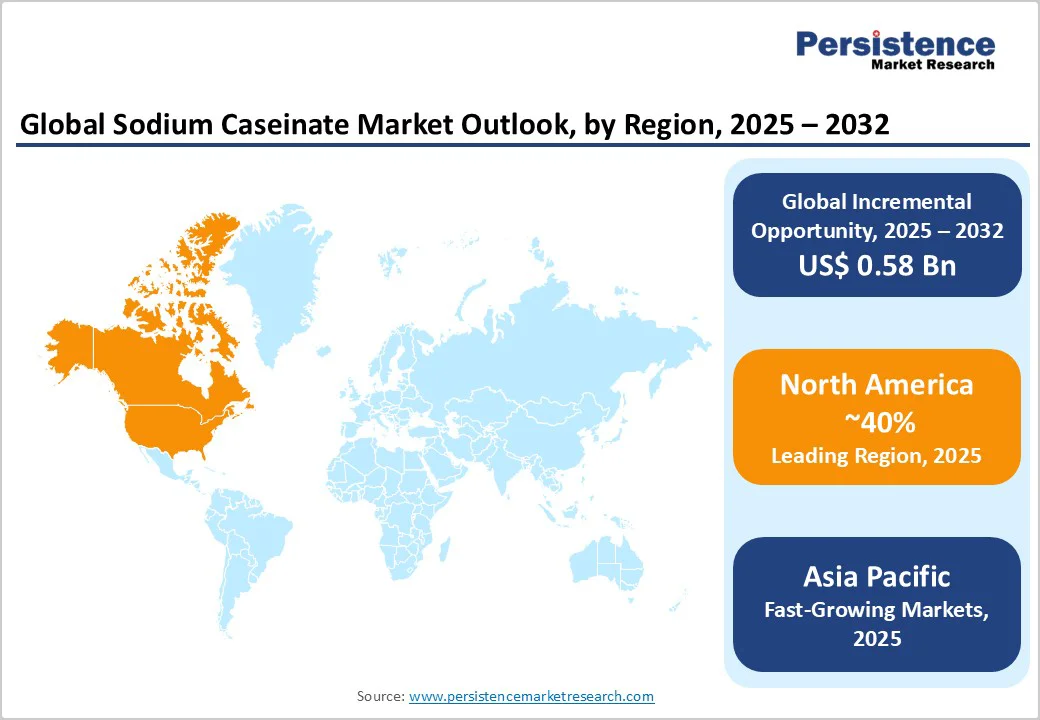ID: PMRREP35795| 192 Pages | 30 Oct 2025 | Format: PDF, Excel, PPT* | Chemicals and Materials

The global sodium caseinate market size is likely to be valued at US$1.2 Bn in 2025 and is projected to reach US$1.8 Bn by 2032, growing at a CAGR of 5.8% between 2025 and 2032.
The Sodium Caseinate market is experiencing steady growth driven by rising demand for protein-enriched foods and functional ingredients across diverse industries.
This growth stems primarily from consumer health consciousness, where sodium caseinate serves as a versatile emulsifier and stabilizer in processed foods, enhancing texture and nutritional profile.
| Key Insights | Details |
|---|---|
| Sodium Caseinate Market Size (2025E) | US$ 1.2 Bn |
| Market Value Forecast (2032F) | US$ 1.8 Bn |
| Projected Growth CAGR (2025-2032) | 5.8% |
| Historical Market Growth (2019-2024) | 4.9% |

The increasing consumer preference for high-protein diets is a primary driver for the sodium caseinate market, as it provides essential amino acids and supports muscle health in supplements and fortified foods. This trend is evidenced by the global rise in sports nutrition products, with health organizations such as the World Health Organization recommending 1.6 grams per kilogram of body weight for active individuals, driving sodium caseinate use in bars and shakes.
Advancements in food processing technologies are driving demand for sodium caseinate as a multifunctional additive, particularly for stabilizing emulsions to extend shelf life in packaged goods. Industry statistics from the International Dairy Federation indicate that processed food output has risen by 25% over the past five years, necessitating ingredients like sodium caseinate to maintain product quality during high-volume manufacturing.
Its compatibility with various formulations, including non-dairy alternatives, supports innovation in clean-label products and aligns with regulatory pushes for natural preservatives. It not only enhances operational efficiency for manufacturers but also meets evolving consumer expectations for nutritious, convenient meals, solidifying sodium caseinate's integral role in the Food Additives Market.
Volatility in milk prices poses a significant restraint on the sodium caseinate market, as it is derived from dairy casein, leading to inconsistent production costs. According to United States Department of Agriculture reports, global milk prices fluctuated by up to 20% in 2024 due to supply chain disruptions and higher feed costs, squeezing producers' margins and deterring investment in capacity expansion.
This instability discourages small-scale manufacturers from entering the market, potentially limiting supply availability and raising end-product costs for food and pharmaceutical applications. Consequently, it hampers overall market accessibility, particularly in price-sensitive regions.
Stringent regulations on milk allergens represent a key barrier, as sodium caseinate must carry labeling warnings, which impact its use in allergen-free product lines. The European Food Safety Authority mandates a clear declaration of milk-derived proteins, with non-compliance fines reaching €100,000, which complicates formulation for global exporters and increases compliance costs by 15-20% as per industry compliance studies.
It fosters hesitation among formulators, especially in the growing plant-based sector, where alternatives are gaining traction, ultimately constraining sodium caseinate's penetration in sensitive markets such as infant nutrition and cosmetics.
Advancements in enzymatic processing offer substantial opportunities for market participants in the sodium caseinate market, enabling lactose-reduced variants that cater to consumers with lactose intolerance while preserving functional benefits.
Recent developments from dairy research institutions highlight that such innovations can improve solubility by 30%, as demonstrated in trials for protein supplements, aligning with the 5% annual growth in clean-label demand reported by consumer trend surveys.
This opens avenues in the expanding sports nutrition segment, projected to add $10 billion in value by 2030 per health industry forecasts, allowing companies to capture premium pricing and diversify portfolios beyond traditional food uses.
The burgeoning pharmaceutical sector presents significant opportunities, with sodium caseinate's binding properties ideal for drug delivery systems such as tablets and injectables, especially amid rising chronic disease prevalence.
World Health Organization data shows global pharmaceutical spending increasing by 6% yearly, driving demand for stable excipients; sodium caseinate's biocompatibility supports this, as evidenced by its use in 20% more bioavailable formulations per recent journal studies.
Targeting emerging markets such as Asia, where healthcare infrastructure expands rapidly, enables companies to forge partnerships with generic drug makers, potentially generating 15% higher revenues through customized grades focused on sustained-release technologies.
The food-grade segment leads the product-grade category in the sodium caseinate market, with a 75% share, driven by its widespread use in consumable products that require high purity and nutritional enhancement. This dominance is justified by regulatory approvals from bodies such as the U.S. Food and Drug Administration, which classify it as generally recognized as safe for food applications, ensuring compliance in dairy and bakery formulations.
Statistics from the International Dairy Federation reveal that food-grade variants constitute 80% of total casein production, underscoring their reliability in stabilizing emulsions and fortifying proteins, particularly in the context of the Casein and Caseinate Market. Industrial-grade, while essential for non-food uses, lags behind due to stricter purity requirements in the edible sector.
In the industry category, food & beverages command a 65% market share in the sodium caseinate market, driven by its critical role in improving texture and enriching protein across sub-segments such as dairy and bakery products. This leadership is supported by Food and Agriculture Organization data indicating that processed food consumption has surged 40% globally since 2019, necessitating versatile additives such as sodium caseinate for ready-to-eat and frozen items.
Its emulsifying prowess in dairy products alone accounts for 30% of its usage, according to industry production metrics, making it indispensable for maintaining product integrity amid rising demand for convenient nutrition. Pharmaceuticals and cosmetics follow but lag due to volume differences.
The food additives segment dominates the application category, with a 55% share in the sodium caseinate market, driven by its multifunctional properties that enhance nutritional value and stability across various formulations. Justification lies in endorsements from the Joint FAO/WHO Expert Committee on Food Additives, which affirms its efficacy as a protein source with no limits on daily intake, facilitating broad incorporation into processed foods.
Usage statistics show it comprises 60% of additive applications in bakery and confectionery, per dairy association reports, directly tying into the Food Additives Market dynamics, where clean-label preferences boost its appeal. Emulsifiers and stabilizers are vital but secondary to this core function.

North America maintains leadership in the sodium caseinate market due to a robust innovation ecosystem and stringent regulatory frameworks that prioritize food safety and nutritional labeling.
The U.S. Food and Drug Administration's GRAS status for sodium caseinate has spurred its integration into high-protein products, with the region's food processing sector expanding by 4% annually, as per United States Department of Agriculture statistics. Recent developments include advanced spray-drying techniques by domestic producers, enhancing solubility for sports nutrition, aligning with consumer trends toward wellness-focused diets.
This region's market dynamics are further strengthened by collaborations between dairy cooperatives and research institutions, focusing on allergen-reduced variants to address lactose intolerance, which affects 30 million Americans. Such innovations not only comply with the Food Allergen Labeling and Consumer Protection Act requirements but also drive exports, positioning North America as a quality benchmark for global standards.
Europe's sodium caseinate market is performing strongly across key countries such as Germany, the U.K., France, and Spain, bolstered by harmonized regulations from the European Food Safety Authority that emphasize sustainable sourcing and allergen disclosure.
In Germany, industrial adoption in pharmaceuticals has grown by 5% annually, supported by news of expanded production facilities in 2024 aimed at eco-friendly processing. The U.K. sees rising use in bakery products, with British Retail Consortium certifications ensuring quality amid post-Brexit trade adjustments.
Regulatory harmonization facilitates cross-border supply chains, enabling France and Spain to leverage their dairy heritage for fermented applications, aligning with the Fermented Dairy Products Market. Recent 2025 developments include policy incentives for protein fortification in school meals, projected to increase demand by 10%, reflecting Europe's focus on public health and circular economy principles in dairy waste utilization.
The Asia Pacific sodium caseinate market is witnessing rapid growth, driven by manufacturing advantages in China, Japan, India, and ASEAN nations, where urbanization is driving processed food consumption up 6% annually, per Food and Agriculture Organization data.
In China, state-backed dairy initiatives have boosted local production, with 2024 news highlighting new facilities increasing output by 20% to meet domestic demand. India's expanding middle class favors protein-enriched RTE products, supported by government subsidies for nutritional programs.
ASEAN's growth dynamics stem from cost-effective sourcing and export-oriented hubs, with Japan innovating in cosmetic applications via advanced encapsulation techniques reported in 2025 industry journals. These factors, combined with rising per capita dairy intake, position the region for accelerated expansion, particularly in the Emulsifiers Market for convenience foods.

The global sodium caseinate market displays a moderately consolidated structure, with a handful of established dairy giants controlling 60% of production through integrated supply chains from milk sourcing to processing.
Companies pursue expansion via strategic acquisitions and R&D investments in sustainable extraction methods, such as enzymatic technologies, to differentiate via eco-friendly profiles. Key differentiators include premium purity grades and customized formulations for end-uses, while emerging models emphasize direct-to-consumer nutrition lines and B2B partnerships for co-development.
The global sodium caseinate market is projected to reach US$ 1.8 Bn by 2032, growing from US$ 1.2 Bn in 2025 at a 5.8% CAGR, driven by protein demand in foods and pharma.
Key drivers include rising consumer preference for high-protein diets and expansion in food processing, with sodium caseinate enhancing texture in 65% of processed foods as per industry data.
Food grade leads with 75% share, favored for its purity in edible applications like dairy and bakery, compliant with FDA standards for nutritional fortification.
North America leads the market, supported by advanced regulations and innovation in protein products, particularly in the U.S. food sector.
Innovations in clean-label pharmaceutical formulations offer 15% growth potential, targeting chronic disease treatments with bioavailable excipients.
Leading players include FrieslandCampina Ingredients, Kerry Group, and Arla Foods Ingredients, controlling 50% share through R&D and global supply chains.
| Report Attribute | Details |
|---|---|
| Historical Data/Actuals | 2019 - 2024 |
| Forecast Period | 2025 - 2032 |
| Market Analysis Units | Value: US$ Mn/Bn, Volume: As Applicable |
| Geographical Coverage |
|
| Segmental Coverage |
|
| Competitive Analysis |
|
| Report Highlights |
|
By Product Grade
By Industry
By Application
By Region
Delivery Timelines
For more information on this report and its delivery timelines please get in touch with our sales team.
About Author